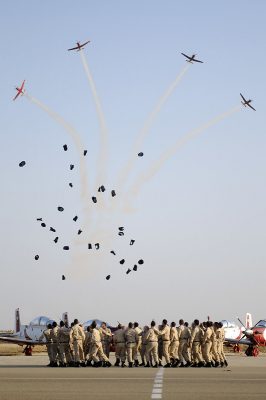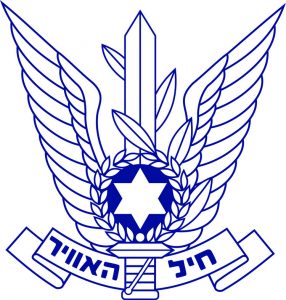×


We have detected your country as:
Please click here to go to the USA website or select another country from the dropdown list.
by: Ilse Posselt, BFP News Correspondent
Say the words “Israeli Air Force” (IAF) and mental images of courage and valor come to mind. The flying force of tiny Israel is, after all, synonymous with legendary missions, seemingly impossible exploits and remarkable bravery.
Today, the IAF is recognized as one of the most powerful air corps in the world. A study by military experts for Business Insider two years ago ranked the Jewish state’s aerial force first internationally. The exceptionally high entry and training standards in the IAF’s flight academy, the study found, produce a distinguished staff of pilots to operate a fleet of the most advanced planes in history. The IAF, it concluded, is a phenomenal force, second to none, ready and equipped to deter threats against the Land of Promise.

This was not always the case. The Chail Ha’Avir, as the Jewish state’s flying corps is called in Hebrew, comes from particularly humble beginnings. In fact, at the time of its birth, nobody would have chosen adjectives like “great,” “phenomenal” or “ready and equipped” to describe it.
The story of modern Israel is woven from the strands of that which defies logic; its building blocks the improbable, miraculous and against-all-odds. The events that form its history echo the biblical accounts of Hebrew kings, prophets and judges who faced mighty armies and marched into hopeless battles—armed with little but the promise of Almighty God. It stands to reason then that the tale of the guardians of the skies of Israel is one that leaves even the most ardent sceptics stumped.
The IAF was born alongside the modern State of Israel in May 1948. Both these births were nothing short of miraculous and took place under perilous circumstances, as the battle for their survival raged.
In the run-up to the declaration of statehood, the fledgling Jewish nation had virtually no army to speak of. Of the nearly 60,000 men and women who stood determined to defend their homeland, only 18,900 were battle ready, the Jewish Virtual Library says. Legend holds that the ragtag army was equipped with five machine guns, fifteen rounds of ammunition and no cannons or tanks. Moreover, Western nations, including America and Britain, enforced a ban on arms shipments to the Jewish state.
Israel knew that a large-scale invasion was imminent, pitting the vastly outnumbered and outgunned Israelis against the onslaught of five Arab armies—all trained, armed to the teeth and ready to “push the Jews into the sea.” Israel was forced to prepare for a war for her survival.
These preparations included assembling an air force from what appeared to be thin air. The state’s first fighter pilots were a handful of World War II veterans from America, South Africa and Australia. The Israeli aerial fleet comprised nine aircraft—all obsolete, while the Egyptian army alone boasted 60 fighter planes, including Spitfires and bombers. With the arms embargo firmly in place, Israel began a frantic search for aircraft with which to defend herself in the coming battle.
Days before the declaration of statehood, the motley band of veteran pilots embarked for Czechoslovakia—one of the only countries willing to sell weapons to the Jews—for flight training in Israel’s very first fighter planes. The aircraft were nothing special—four rickety machines hastily pieced together from dismantled German warplanes. Desperate times call for desperate measures.
 Victory Despite the Odds
Victory Despite the OddsThe men who would be responsible for guarding the skies of the nation duly took their aircraft apart, airlifted the pieces to the Jewish homeland and set about reassembling the parts into the four makeshift planes that would serve as Israel’s aerial fighting force in one of its bloodiest wars. Israel’s enemies came for the kill one day after the announcement of the rebirth of the State on 14 May, 1948.
A few days later, Egyptian forces advanced within miles of Tel Aviv. With the very existence of Israel in the balance, the Jewish state’s air force of four planes set out on the seemingly impossible mission of halting the advance columns. The ramshackle planes inflicted no real damage. Yet the Egyptians, who assumed that Israel had no aerial fleet, retreated in fear. Tel Aviv—and Israel—was saved, thanks to a fleet of four dilapidated planes and a crew who clung to victory regardless of the odds.
In the 67 years since the birth of the IAF the list of tales of legendary missions, seemingly impossible exploits and remarkable bravery have continued to grow: from the miraculous destruction of the Egyptian air force during the Six Day War, the unmatched airlifts of Operations Solomon and Moses that saved thousands of Ethiopian Jews, to the outrageous counter-terrorist operation that rescued Israeli hostages held at Entebbe Airport in Uganda.
To this day, the IAF is adding strands to the story of the modern State of Israel which continues to echo the biblical accounts of soldiers, kings and prophets who faced their enemy—armed with the promise of Almighty God.
Photo Credit: IDF/flickr.com
All logos and trademarks in this site are property of their respective owner. All other materials are property of Bridges for Peace. Copyright © 2025.
Website Site Design by J-Town Internet Services Ltd. - Based in Jerusalem and Serving the World.